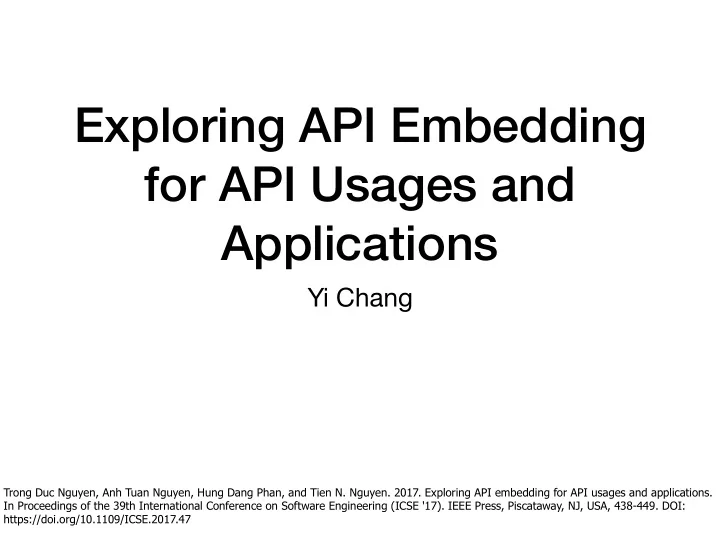

Exploring API Embedding for API Usages and Applications Yi Chang Trong Duc Nguyen, Anh Tuan Nguyen, Hung Dang Phan, and Tien N. Nguyen. 2017. Exploring API embedding for API usages and applications. In Proceedings of the 39th International Conference on Software Engineering (ICSE '17). IEEE Press, Piscataway, NJ, USA, 438-449. DOI: https://doi.org/10.1109/ICSE.2017.47
Stochastic Gradient Descent statistical gradient descent is for minimizing an objective function that is written as a sum of di ff erentiable functions. source: https://en.wikipedia.org/wiki/Stochastic_gradient_descent
AST (Abstract Syntax Tree) Tree representation of the abstract syntactic structure of source code. The author traverses an AST to build API sequences according to the syntactic units related to APIs. Each node of the tree denotes a construct occurring in the source code. The ‘abstract’ here means that the tree does not represent every details appearing in the real syntax. For example, grouping parentheses are already implicit in the tree structure. Source: https://en.wikipedia.org/wiki/Abstract_syntax_tree
Word2Vec — CBOW model Multiple degrees of similarity: simple syntactic regularities, simple algebraic operations. like vector(‘King’) - vector(‘man’) + vector(‘woman’) Continuous Bag-of-Words models: predicting/generating a center word from the surrounding context 1. Generate index vector (1*V) for the input context of size 2n (context window’s size) and get encoded into the model 2. Compute the hidden layer h. Average these vectors. Computes the product of the average vector and the input-to-hidden weights matrix. 3. Inputs to each node in the output layer. 4. Pass the above through the soft-max function. Learn the weight matrix with back-propagation: Stochastic gradient descent. Loss function Source: http://mccormickml.com/assets/word2vec/ Alex_Minnaar_Word2Vec_Tutorial_Part_II_The_Continuous_Bag-of-Words_Model.pdf
Word2Vec — CBOW model (cont) Characteristics of API embeddings: 1. Nearby vectors represent APIs with similar context 2. Similar vector o ff sets reflect similar relations
Word2Vec — Skip-gram model Given the center word, the model predicts/generates the surrounding words. Architecture: 300 features is what Google used in their published model trained on the Google news dataset window size of two train the neural network by feeding it word pairs, Output layer is actually a soft-max regression classifier Source: http://mccormickml.com/2016/04/19/word2vec-tutorial-the-skip-gram-model/
BLEU (Bilingual Evaluation Understudy) It is a popular metrics in Statistical Machine Translation (SMT) that measures translation quality by the accuracy of translating n-grams to n-grams with various n. The BLEU is applied for evaluating lexical matching when migrating equivalent API usage sequence BP is the brevity penalty value, c is the length if the candidate translation and the r is the length of reference corpus length. P_i is the metrics for the overlapping between the bag of i-grams appearing in the candidate sentences and that appearing in the reference sentences. Usually, the N is set to be 4 and Wn = 1/N Kishore Papineni, Salim Roukos, Todd Ward, and Wei-Jing Zhu. 2002. BLEU: a method for automatic evaluation of machine translation. In Proceedings of the 40th Annual Meeting on Association for Computational Linguistics (ACL '02). Association for Computational Linguistics, Stroudsburg, PA, USA, 311-318. DOI: https:// doi.org/10.3115/1073083.1073135 Anh Tuan Nguyen, Tung Thanh Nguyen, and Tien N. Nguyen. 2013. Lexical statistical machine translation for language migration. In Proceedings of the 2013 9th Joint Meeting on Foundations of Software Engineering (ESEC/FSE 2013). ACM, New York, NY, USA, 651-654. DOI: https://doi.org/10.1145/2491411.2494584
Thanks
Recommend
More recommend